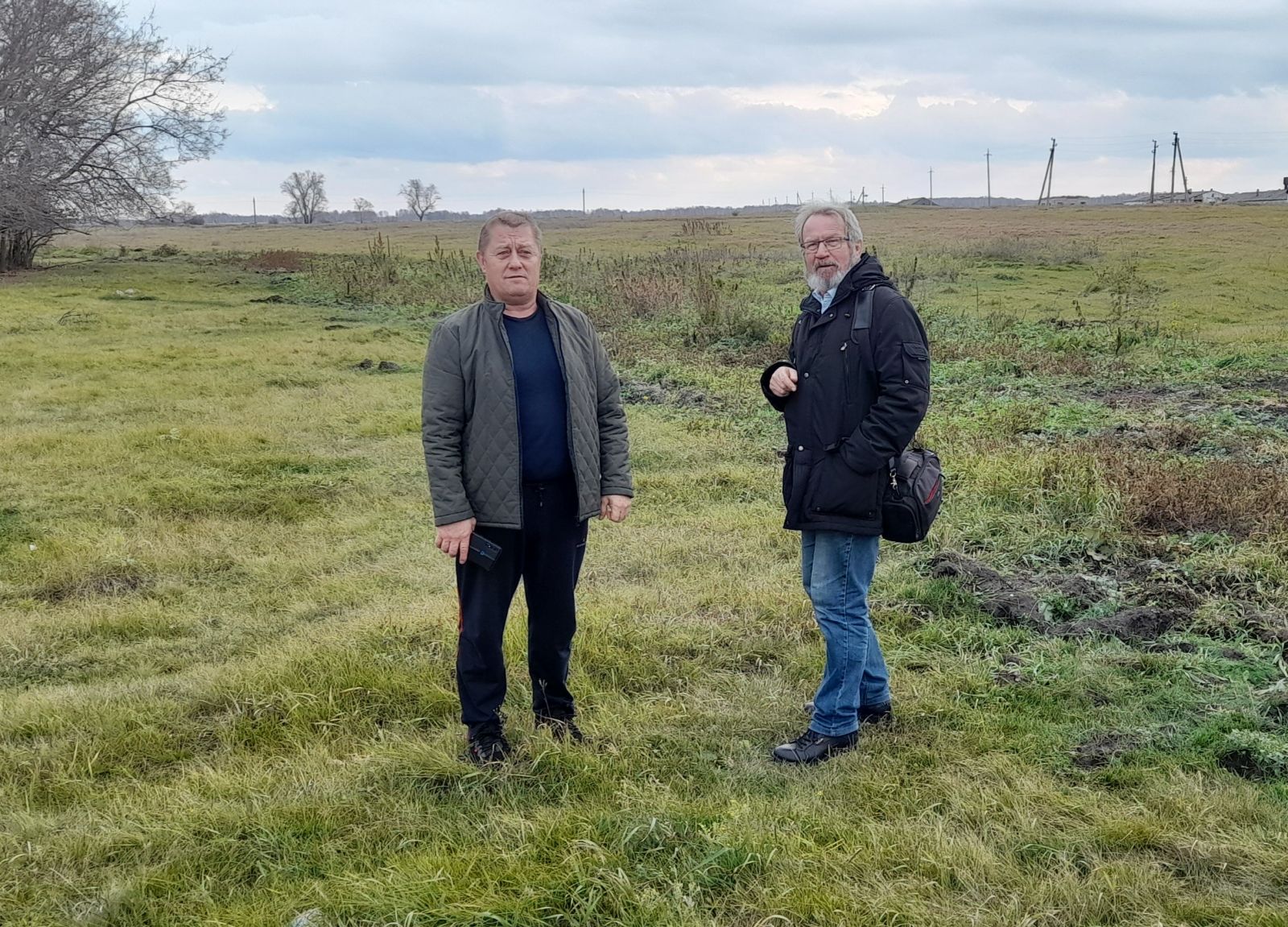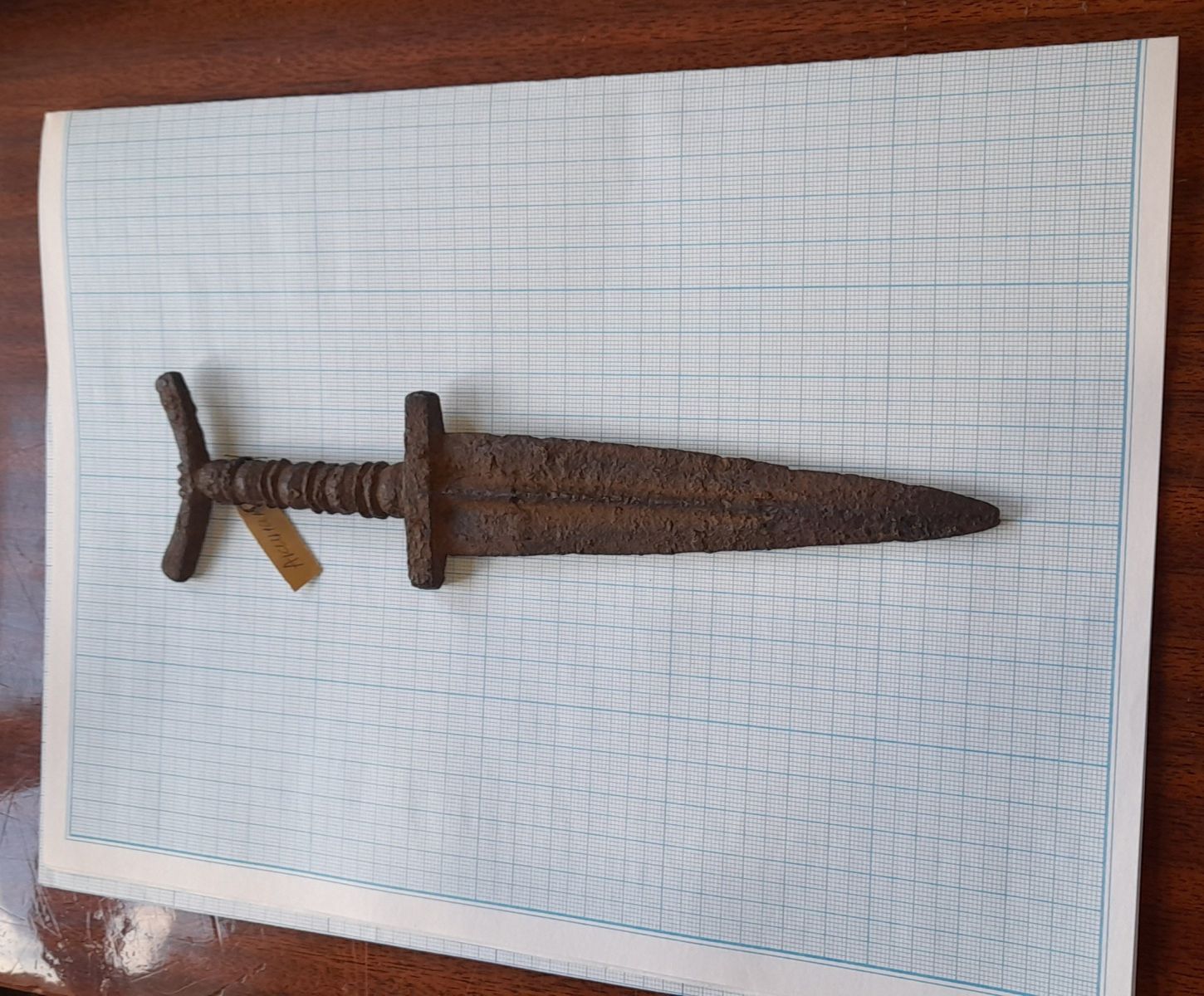“An iron dagger with a grooved handle is missing. If you find it, please return for reward.” Such an announcement could have been given by the owner of this precious and unusual thing if he had an opportunity to do so. There was no writing at that time. But the dagger was indeed found. 24 centuries later. And now scientists are solving riddles.
The first and only
The academic interest coincided with the journalistic one. That is why, on Saturday, together with Aleksandr Tairov and a team of local historians, we set off to the Kurgan Region. A unique artefact that has been haunting a scientist of South Ural State University for two years now is kept at Kataisk District Museum.
Aleksandr Tairov learned about this mysterious exhibit from Vladimir Girnik, a famous local historian of the Krasnoarmeyskiy District of the Chelyabinsk Region. Judging by the photographs, the scientist determined the age of the artefact. It is well preserved; typical features of Early Iron Age daggers are observed. Director of the SUSU Eurasian Studies Research and Education Centre, Doctor of Sciences (History) Aleksandr Tairov conducts research studies connected precisely with this historical period. Yet photographs do not help determine the size of it, examine the design details, or find out about the technology of its manufacturing. It is necessary to measure all the parameters, make cross sections of the blade and handle parts. All of this is obligatory for scientific research work.

The aim of the trip to Kataisk is to describe and sketch contours of the ancient dagger, which is of interest from many points of view. Indeed, in the context of the Sarmatian world such a finding is the first and only so far.
Finally, we are at the museum. We receive a warm welcome with hot tea and pies from its Director Olga Zelenina. We can see the dagger with an arched pommel and a straight crosshair before us. The uniqueness of the exhibit lies in its grooved handle. It probably imitates its organic design. At that time, the iron base of the hilt of swords and daggers was wrapped with leather or birch bark ribbons. And here everything is made in metal.
But the second riddle is much more complicated. The thing is that it was impossible to use this dagger in real life. The handle is too small for a warrior’s palm. This is most likely a votive dagger or a symbol of a dagger. Maybe it was created specifically for burying?
“On the territory of, say, Altai, there are three types of ancient daggers: real size, scaled-down and miniature ones. The object under study fits exactly into the scaled-down dagger category. And miniature ones are extremely small and symbolic. When a man got equipped for his final journey, what was placed in the burial place was not a real dagger, which was quite expensive, but a simple miniature of it, which did not require big manufacturing costs. But this dagger’s manufacturing technology is not very simple,” says the Professor.
Creating such a grooved handle required a certain skill from the blacksmith. I hope that when searching for analogues of this artefact, we will determine the region from where such daggers could have come to the territory of the South Urals, and find out where the centre of their production was. One thing is clear for now: it was not created by local craftsmen. Our daggers of this type have a simple handle in the form of an undecorated strip of iron. And here the blade itself is complex, and so is the handle.”

Room for versions
Maybe it was a child’s dagger?
Perhaps. But… of a very high social rank child. There is another theory. Maybe it was a shaman’s tool for initiation. Such ritual was held in traditional societies when boys entered adulthood. At the same time, scientists noticed that the initiation rite took place earlier among the nobility than among ordinary people. In the Kichigino burial site, for example, we conducted excavations and discovered the remains of a 12-13 year old boy with a full set of weapons and horse harness, like of an adult warrior. There were daggers, a horse bridle, and a quiver of arrows.
Maybe this dagger was presented to boys during initiation. You know... it is like on Archaeologist’s Day, first-year students who were on an expedition for the first time put their hands to the shovel. One of the obligatory elements of the ritual is to kiss an ordinary working shovel, which is our main tool. It is possible that something similar happened there too.
Versions are many. Yet, unfortunately, we do not know the context. If the dagger had been found in a burial, it would have been possible to take the bones to determine the age of the buried person, find out the social status, and some other things. And here is a random finding. Therefore... there is room for versions.
According to Aleksandr Tairov, such daggers are dated by the shape of the blade, crosshair and pommel. This is the 4th century BC. If the dagger had been found in the steppe zone of the South Urals, we could have assumed that it had belonged to the Sarmatians. But we have a forest-steppe zone, and two main groups of the population lived here during this period: bearers of the Gorokhov and Sargat cultures. And the Gorokhov culture was characterized by its close ties with the Sarmatian world.
Professor Aleksandr Tairov is now actively working on the topic of Interaction between the Population of Steppe and Forest-steppe of the Trans-Urals. How did peoples cooperate? What did they exchange? As part of the Priority 2030 program, SUSU scientists are implementing a project that examines the South Trans-Ural region in the system of regional and interregional economic and cultural relations from ancient to modern times.
On the territory of the Shulgan-Tash cave complex, Ufa scientists are conducting classes at an archaeological school. At their invitation, Aleksandr Tairov presented a report for school pupils of the Uchalinskiy District of Bashkortostan and Magnitogorsk. He spoke about the early Iron Age and a unique Sarmatian-type dagger from the Kataisk Museum. The presented information sparked great interest among school pupils and Ufa colleagues working on this era.

Gifted never sold
But how did this mysterious exhibit appear at the museum?
“Such random findings are a unique opportunity to replenish museum funds,” says Olga Zelenina. “This dagger was found by a teacher of physical education on the dump of a firebreak at Shutikha school on the outskirts of the village in spring three years ago. Sergei Bulygin immediately realized that this was not a simple piece of hardware, but a necessary and important thing for scientists. He decided to donate the dagger to our museum, for which we are very grateful.”
We set off to the village of Shutikhinskoye (Shutikha) of the Kataiskiy District of the Kurgan Region. This Russian settlement is more than three hundred years old. We were to meet the donator of the dagger.
The local resident led us to the outskirts of the village. He showed the location where the artefact had been found. Judging by the topography, there are no ancient burial grounds here. Most likely, an unlucky owner of the dagger simply accidentally dropped this expensive item in the early Iron Age.
It turned out that Sergei Bulygin was a veteran of Afghan war and that was not his first finding. The flail, presumably of the 18th century, was given by him to the school several years ago.
“I think there would be many antique lovers who would like to buy your findings for their private collections for some good money... Did you ever think about selling them?” I finally asked Sergei Bulygin.
“You know, I am this kind of person…” he mused for a few seconds. “This is history. This is our Motherland. I cannot sell it.”
P.S. Professor Aleksandr Tairov is working on an article dedicated to the unique dagger for one of the journals included in Scopus. Colleagues from other regions are already asking questions on the topic and are looking forward to this publication. Let us hope there is a new scientific discovery ahead.




